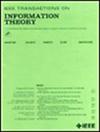The Duality Upper Bound for Finite-State Channels With Feedback
IF 2.2
3区 计算机科学
Q3 COMPUTER SCIENCE, INFORMATION SYSTEMS
引用次数: 0
Abstract
This paper investigates the capacity of finite-state channels (FSCs) with feedback. We derive an upper bound on the feedback capacity of FSCs by extending the duality upper bound method from mutual information to the case of directed information. The upper bound is expressed as a multi-letter expression that depends on a test distribution on the sequence of channel outputs. For any FSC, we show that if the test distribution is structured on a带反馈的有限状态信道的对偶上界
研究了带反馈的有限状态信道的容量问题。将互信息的对偶上界方法推广到有向信息的情况下,得到了FSCs反馈能力的上界。上界表示为一个多字母表达式,该表达式取决于通道输出序列上的测试分布。对于任意FSC,我们证明了如果测试分布结构在q图上,则上界可以表示为状态为信道状态信念的马尔可夫决策过程(MDP)。在fsc和状态相同或具有有限内存的情况下,MDP状态简化为在有限集合中取值。因此,MDP由有限数量的状态、动作和干扰组成。MDP的这种有限性质非常重要,因为它确保动态规划算法可以求解相关的Bellman方程以建立解析上界,即使对于具有大字母的信道也是如此。我们通过建立一个广泛的噪声输出状态(NOST)通道的容量作为一个简单的封闭形式的分析表达式来证明计算边界的简单性。此外,我们还引入了噪声伊辛信道容量的新颖的、近似最优的解析上界。
本文章由计算机程序翻译,如有差异,请以英文原文为准。
求助全文
约1分钟内获得全文
求助全文
来源期刊

IEEE Transactions on Information Theory
工程技术-工程:电子与电气
CiteScore
5.70
自引率
20.00%
发文量
514
审稿时长
12 months
期刊介绍:
The IEEE Transactions on Information Theory is a journal that publishes theoretical and experimental papers concerned with the transmission, processing, and utilization of information. The boundaries of acceptable subject matter are intentionally not sharply delimited. Rather, it is hoped that as the focus of research activity changes, a flexible policy will permit this Transactions to follow suit. Current appropriate topics are best reflected by recent Tables of Contents; they are summarized in the titles of editorial areas that appear on the inside front cover.
 求助内容:
求助内容: 应助结果提醒方式:
应助结果提醒方式:


